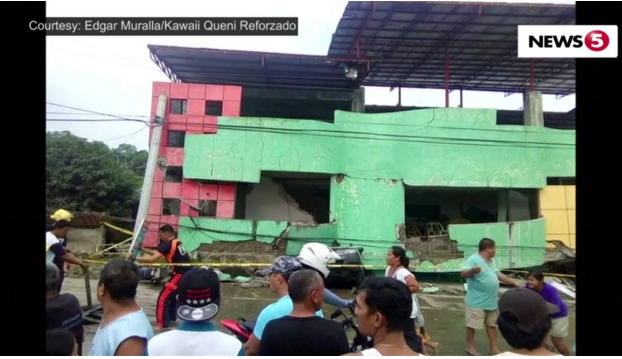
ORMOC, Leyte, Philippines – Some 2,000 people in mountainside barangays have set up improvised tents from tarpaulins and other similar materials even as they brave aftershocks and the threat of more landslides, such as those triggered by the magnitude 6.5 earthquake that struck Eastern Visayas on Thursday (July 6).
A News5 team that visited Sitio Dos in Barangay Tongonan in Ormoc, saw the extensive damage caused by the temblor on the roads, huge segments of which sustained large and long cracks, or were forced open wide.
In some parts, the road was pushed up as high as three feet.
Almost all homes in the barangay at the foothills of the mountain were destroyed.
Even a nearby basketball court that the village youth had been using could no longer be used.
Many of the residents had also been victims of super typhoon Yolanda in November 2014, but said their misery now was worse. The damage was greater, and they had no time to prepare for it because there is no warning for an earthquake, unlike a storm.
Electricity has been cut since Thursday, and getting clean and adequate water is a challenge.
As most of the homes are too risky to live in, most residents set up all forms of improvised shelters outside. They fear that if they return home, subsequent landslides that aftershocks may trigger could bury them completely.
As of Sunday morning, Phivolcs had recorded 561 aftershocks, 11 of which were felt by people.
There are not enough tarps to go around, and residents have collected all possible alternatives like plastic sheets, to shield them from rains.
The residents live near the geothermal plant in Kananga town, which supplies power to a huge part of Eastern Visayas, Bohol, and parts of Cebu and Western Visayas.
In a nearby village of Libertad, in Kananga, residents face the same problems.
Most quake victims are asking for help by way of financial aid and construction materials to allow them to repair their homes.
They are also asking for tarps or plastic sheets, sleeping mats, food, medicine, hygiene kits and clean water.
As of Saturday, the Energy Development Corporation had reported that all of its Leyte power plants are still shut down while assessment of the full extent of damage is ongoing.
Energy Secretary Alfonso Cusi inspected the facilities along with EDC President Richard Tantoco, who has been at the site since Friday.
Based on the ongoing assessment, so far, EDC has provided the following updates and estimates:
The Tongonan Geothermal Power Plant Unit 1 may not be operational for some time due to cooling tower damage. Unit 2 (35MW) may be operational in the next 7 to 10 days as tests on the unit and the main transformer as well as cooling tower repair need to be performed.
The Upper Mahiao plant is also expected to return to operation in five to seven days bringing 132MW back to the grid. For the Malitbog power plant, Units 1 and 2 are estimated to return to service within the next 7 to 10 days bringing about 150MW of power back online. Unit 3 however will remain on shutdown due to damage sustained by the cooling tower.
“Access to our Mahanagdong plant remains difficult and we have not yet been able to assess the extent of damage,” EDC said in an update Saturday afternoon.
“We are still working to clear landslide debris. Barring any unforeseen issues, EDC could have about 317 MW of power restored to Leyte within the next 10 days.
“Meanwhile, repair of the marshalling station has commenced and we expect it to be operational in three to five days. Aside from transmitting power from our plants, these repairs will also allow the connection of the station to the 230 kV line to Luzon.
“Our team of contractors has been mobilized to work 24/7, safety considerations permitting, to complete the assessment and accelerate return to service,” EDC said.









